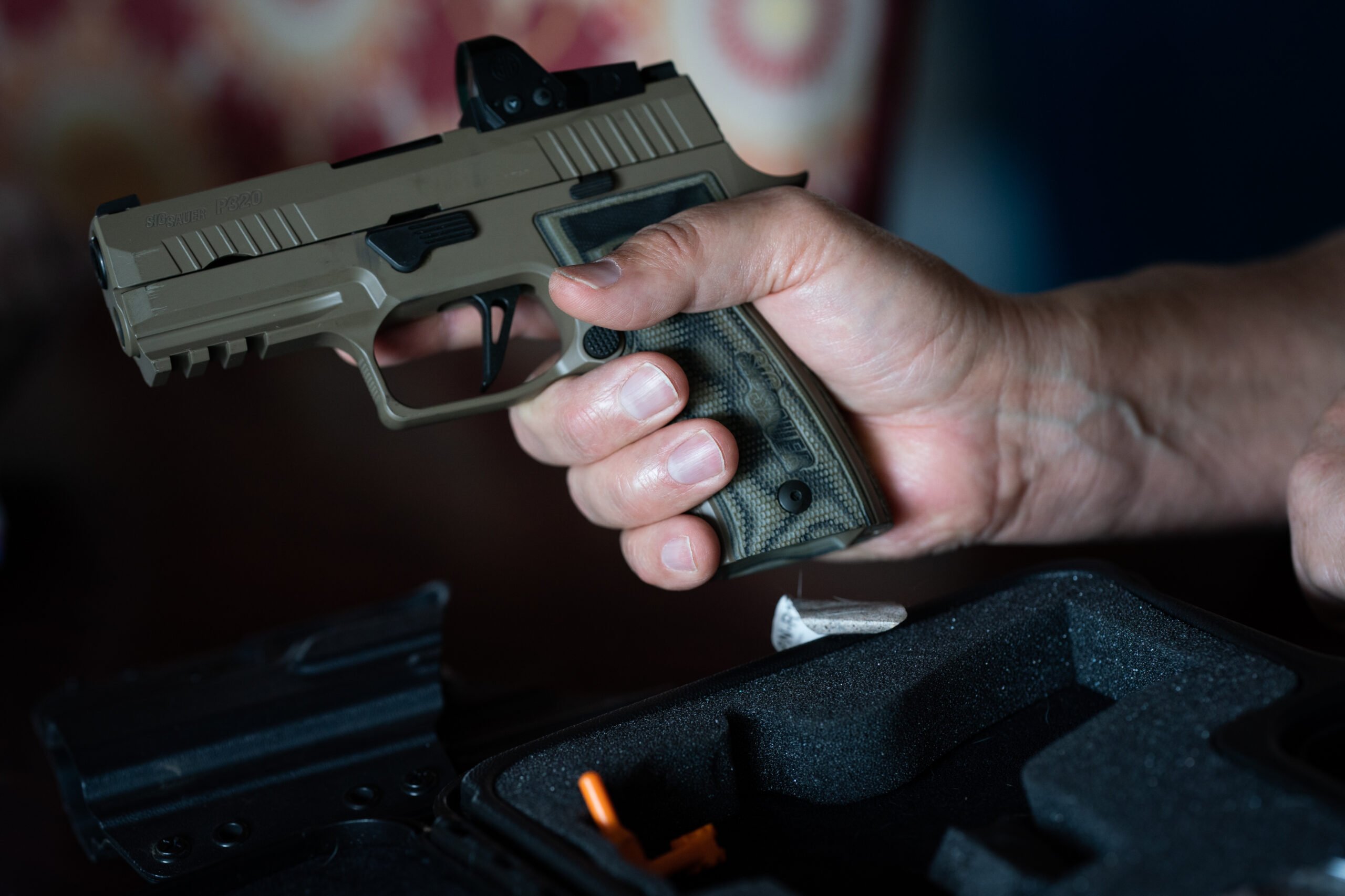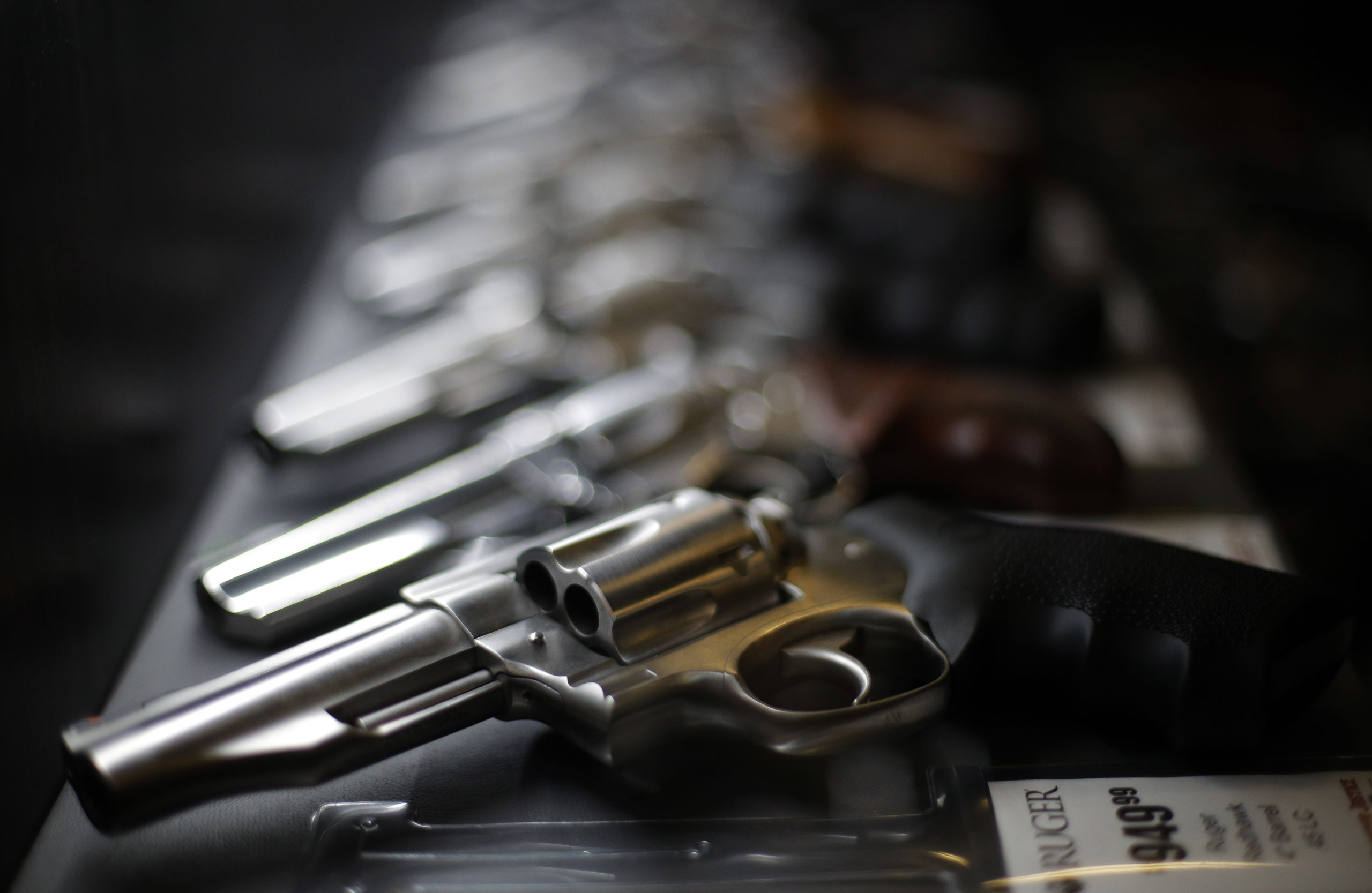One warm afternoon in May, Dwight Jackson was getting dressed for a visit to his favorite cigar lounge. He slipped his holstered SIG Sauer P320 pistol onto his belt, put on a button-down shirt, and leaned across his bed for his wallet. Suddenly, he said, the gun fired, sending a bullet tearing through his right buttock and into his left ankle.
“I heard ‘bang!’” said Jackson, 47, a locomotive engineer who lives in Locust Grove, Georgia. “I looked down and saw blood.”
His wife heard the shot from down the hall and screamed. She called an ambulance while Jackson hobbled toward the front door, painting a trail of blood over the hardwood floors.
At no point, Jackson later told police, had he touched the gun’s trigger.
The P320 is one of the nation’s most popular handguns. A variant of the weapon is the standard-issue sidearm for every branch of the U.S. military. Since its introduction to the commercial market in 2014, manufacturer SIG Sauer has sold the P320 to hundreds of thousands of civilians, and the gun has been used by officers at more than a thousand law enforcement agencies across the nation, court records show.
It has also gruesomely injured scores of people who say the gun has a potentially deadly defect.
More than 100 people allege that their P320 pistols discharged when they did not pull the trigger, an eight-month investigation by The Trace and The Washington Post has found. At least 80 people were wounded in the shootings, which date to 2016.

“The number and frequency of injuries are strongly suggestive of a design flaw versus a human performance error,” said Bill Lewinski, a behavioral scientist and executive director of the Force Science Institute and one of the nation’s leading experts on accidental shootings. “What we’re seeing is highly unusual.”
The injured included both casual and expert firearm owners whose guns fired in their homes and offices and in busy public places like casinos and parking lots. In two cases, the guns went off on school grounds.
Interviews with more than a dozen victims, video recordings, and a review of thousands of pages of court documents and internal police records reveal a pattern of discharges that were alleged to have occurred during routine movements. These have included the holstering or unholstering of the P320, climbing out of vehicles and walking down stairs. In several cases, records and videos show, the gun fired when a victim’s hand was nowhere near it.
Navy veteran and former gunner’s mate Dionicio Delgado said his P320 fired a bullet through his thigh and into his calf after he holstered it during a training session at a gun range in Ruther Glen, Virginia. Michael Parker, a welder, said his holstered P320 fired a bullet into his thigh as he removed the holster from his pocket while in his car in St. Petersburg, Florida. Police officer Brittany Hilton said her holstered P320 fired while inside her purse as she walked to her car in Bridge City, Texas. The bullet entered her groin and exited her back just inches from the base of her spine.
In a written response to questions, SIG Sauer, based in Newington, New Hampshire, denied that the P320 was capable of firing without a trigger pull and cited accounts of unintentional discharges with other firearms as evidence that such issues with the P320 are neither uncommon nor suggestive of a defect with the gun.
“These reports, among others, support three conclusions,” the response reads. “(1) unintentional discharges are not uncommon amongst both law enforcement and civilians, (2) improper or unsafe handling is one of the most common causes of unintentional discharges, and (3) unintentional discharges occur with several types of firearms and are not unique to the P320.”
The response further noted that “despite years of litigation and extensive discovery, no one, including plaintiffs’ ‘experts’, have ever been able to replicate a P320 discharging without a trigger pull,” and that the P320 conforms to applicable U.S. standards for safety. “The SIG Sauer P320 model pistol is among the most tested, proven, and successful handguns in small arms history,” the company wrote.
Experts said the risk of unintentional discharges tends to be greater for law enforcement officers because they are frequently trained to keep a round chambered in their duty weapon, which they often wear on their hip throughout the day.
At least 33 officers at 18 law enforcement agencies have been injured by P320 discharges, according to court records and interviews. At least six agencies removed the P320 from service over concerns about the model’s safety, records show.
“I’ve been running a gun store for over 10 years at this point, and you always hear anecdotal statements about some gun going off,” said Jeff Webb, a certified master gunsmith who operates Grey Wolf Armory, a gun store in a Tampa Bay suburb. “But dozens of injuries of local and federal police agents over the last five years — that’s not an anecdote, that’s a problem.”
Webb has for years publicly criticized the P320 as unsafe and was recently retained as an expert witness in a case against the gunmaker.
Most of the incidents occurred after SIG Sauer changed the internal design of the P320 following reports that the pistol could fire when dropped and launched a voluntary upgrade program allowing gun owners to send their pistols to the company’s New Hampshire factory for modification.
At least 35 shootings — including Jackson’s, Delgado’s, and Hilton’s — involved guns with the new design or older guns that were sent back to SIG Sauer for upgrades, according to court filings and a review of the firearms used in the shootings.
Webb and other critics of the P320 say the versions used most often by civilians and police are essentially cocked at all times, with no external safeties to prevent the guns from firing in cases of malfunctions. These design features make them especially vulnerable to unintentional discharges, critics say.
Firearms are one of the few products that are exempt from federal consumer safety regulations. No regulatory body has the power to investigate alleged defects or impose a mandatory recall of guns. As thousands of P320s circulate in the civilian market, waiting for buyers, SIG Sauer faces lawsuits from at least 70 people who allege the company is selling a defective product.

Jackson, a former track and football player with two children, can no longer run as a result of his injuries and struggles to use stairs. He’s grateful to be alive after the bullet nearly hit his femoral artery, which could have caused massive blood loss and possibly death.
But he’s worried that if SIG Sauer doesn’t implement changes, the next victim won’t be so lucky.
“If somebody is telling you that something is not right, that they see smoke, there must be fire somewhere, right?” Jackson said. “You expect a company to address that. But SIG is not addressing it.”
Exempt From Product Safety Regulations
The Consumer Product Safety Commission (CPSC) has required recalls of candles whose flames burn too tall, fleece pajamas shown to cut infants and classroom chairs with loose welding.
But it has never ordered a recall of a gun because it does not have the authority to do so, even if the weapon explodes in someone’s hand or spontaneously fires a bullet.
The omission is the result of an amendment written by U.S. Representative John D. Dingell in 1972, when the agency was created by Congress. Dingell, a Democrat from Michigan who was also a gun rights supporter and who sat on the National Rifle Association’s board of directors, would later describe efforts to allow the CPSC to regulate firearms as “outrageous” and “harassing the firearms manufacturers.”
Critics said the result of this political deal has endangered gun owners.
“These are products that pose a greater safety risk if they malfunction than a bike or a toaster,” said Teresa Murray, director of the consumer watchdog office at the U.S. Public Interest Research Group, a consumer advocacy nonprofit. “The consumer is paying the price.”
Without federal oversight, gunmakers themselves are left to investigate reported defects and inform consumers of potential issues with their products. On multiple occasions, manufacturers have opted to ignore long-standing problems, taking action only when facing pressure from lawsuits or bad publicity.

The gunmakers Remington Arms and Taurus have both faced class-action lawsuits over weapons with alleged defects that have cumulatively injured or killed dozens of people.
SIG Sauer has faced claims that the P320 malfunctions since at least 2017, when accounts surfaced that the gun could fire when dropped. A video released in August that year by a Texas gun store showed the gun firing consistently when dropped at certain angles. The impact caused the trigger to depress, the video showed.
A day after the video was released, SIG Sauer announced that it would modify the pistol’s design and launched a voluntary upgrade program through which customers could return their guns to have redesigned components installed. Reporting by CNN later showed that SIG Sauer had been notified twice about instances in which the gun fired when dropped, roughly a year before warning the public of the problem. One of those notices was from the U.S. Army.
In a response to questions, SIG Sauer wrote that “it is important to note that the [Voluntary Upgrade Program] was not prompted by any particular claim and is entirely unrelated to any allegation that the P320 can discharge without a trigger pull, or other claims of unintentional discharges.”
SIG Sauer did not replace the guns sitting on gun store shelves across the country or require retailers to inform customers of the gun’s potential risks.
“If I had known about this gun’s problems, it would not have been the gun I carried,” said George Abrahams, 55, an Army veteran in Philadelphia whose P320 sent a round into his thigh in 2020. He had purchased the gun in 2018 — a year after the upgrade program had been in effect — but it had not been upgraded and he was not warned at the gun shop of the firearm’s potential issues.

Harvey Winingham, 74, a retired Air Force veteran living in Maricopa County, Arizona, sought to avoid this risk when he acquired his P320 in a private sale in early 2018. When he learned of SIG Sauer’s design change, he shipped the weapon back to the gunmaker for an upgrade. But two years later, as he inspected the weapon for a chambered round, it fired a bullet through his hand, Winningham said.
“I got the gun upgraded as soon as I could because I didn’t want this to happen to me,” he said. “But here we are now. It happened anyway.”
In court documents, SIG Sauer denied that either Abrahams’ or Winingham’s guns could have fired without their triggers being depressed by a finger or foreign object.
Democrats in Congress have repeatedly tried to establish a regulatory authority with the power to investigate reports of defective firearms and require recalls. The charge has been led by Representative Debbie Dingell, a Democrat from Michigan and the widow of John D. Dingell, whose amendment created the exemption five decades ago. Her proposed legislation has never made it to the floor for a vote.
“People are dying,” she said, “and no one’s got oversight.”
“Uniquely Dangerous”
The P320 is what’s known as a striker-fired handgun. With each pull of the trigger, an internal, spring-loaded pin called a striker rushes forward to detonate a bullet’s primer and send a round hurtling out of the barrel.
But the P320 is different from many striker-fired guns in that it is effectively fully cocked at rest. The pull of its trigger does not draw the striker backward any meaningful distance. It simply releases it.
The few gun models with similar designs generally mitigate the risk of an unintentional discharge by installing one or more external safeties, which prevent the guns from firing unless they are manually deactivated. Manual thumb safeties, for example, allow the user to toggle between a mode where the trigger can be pulled and a mode where it cannot.
The military variant of the P320 includes a manual thumb safety, and SIG Sauer offers military-branded versions of the gun for civilians that also incorporate one. All but one civilian-branded model of the P320 have no such safety mechanism, according to a review of available P320 models on SIG Sauer’s website.
Civilian models of the P320 have two internal safeties, but neither can be controlled by the user. The primary internal safety is designed to catch the striker in the case of a malfunction. A second mechanism prevents the weapon from discharging when its slide is drawn backward.
According to an October report from James Tertin, a gunsmith at the Minnesota-based gun manufacturer Magnum Research, this is a highly unusual and “uniquely dangerous” configuration, which is found in only two models of SIG Sauer pistols. (Magnum Research is a subsidiary of the gunmaker Kahr Arms, which also produces pistols sold in the United States.)
In the report, commissioned by a legal team bringing a case against SIG Sauer in Philadelphia, Tertin opined that the P320’s primary internal safety was too easily disabled. He found that pulling the trigger 0.075 inches — about the width of a nickel — would disengage it, leaving the pistol vulnerable to accidental discharge.
“Given the very minimal trigger movement… required to disengage the internal safeties, a foreign object or pressure against the holster can leave the gun unacceptably vulnerable to a discharge without an intentional trigger pull,” Tertin wrote in his report.
SIG Sauer noted that in deposition testimony, Tertin has said the P320 cannot fire without its trigger being fully depressed. But Tertin has wavered on this point across multiple depositions and has maintained in his expert reports that the gun is vulnerable to firing when the trigger is only partially pulled, as it might be in a warped holster or when a finger or object inadvertently brushes the trigger from its side.
Other experts consulted by The Trace and the Post said the P320 could fire if jostled or slammed while the trigger is depressed enough to disengage the gun’s internal safeties.
The company added that the P320 has “endured extremely rigorous testing” and that the gun “conforms to standards” of the National Institute of Justice (NIJ), the Sporting Arms and Ammunition Manufacturers’ Institute (SAAMI), and other federal and state agencies. On its website, the company has assured customers that the gun “meets and exceeds all US safety standards.”
But while gunmakers and stores must obtain federal licenses to operate, the United States imposes no mandatory standards for the safety of the guns themselves.
The national standards SIG Sauer says it meets are voluntary. The NIJ, an arm of the Justice Department, conducts compliance testing for law enforcement pistols. SAAMI is a trade association (of which SIG Sauer is a voting member) that devises testing protocols implemented by manufacturers themselves. Neither organization requires guns to include specific safety mechanisms nor undergo endurance testing, which evaluates a firearm’s performance after prolonged use.
In court, Sean Toner, the P320 designer, has acknowledged that “U.S. standards are not very stringent.”
Despite the many lawsuits against SIG Sauer and claims of errant discharges, legal teams and police departments have been unable to document the gun’s alleged defective discharges in a controlled setting.
Lawyers representing victims and firearm experts critical of the P320 argue that it is notoriously difficult to replicate mechanical failures in guns, which often depend upon slight shifts of tiny parts inside the weapon. Internal components may be distorted by temperature, moisture, or general wear when they fail, experts say.
During litigation against the gunmaker Remington, victims struggled for years to consistently reproduce inadvertent firings that happened under nearly identical conditions across the country.
“It’s a big challenge for plaintiffs’ attorneys to show the gun has problems when whole police departments have been unable to recreate it,” said Curtis Marshall, a former agent at the Bureau of Alcohol, Tobacco, Firearms and Explosives and U.S. Park Police officer who now offers weapons training to law enforcement.
He added that accidental discharges can be caused by improper ammunition, worn holsters or foreign objects working their ways into the trigger guards.

Robert Zimmerman, a lawyer representing more than 40 clients in lawsuits against SIG Sauer over the P320, said that while understanding the precise mechanism of the P320’s failure is important, the sheer number of incidents — at least nine of which have been caught on video — confirm there is a problem. He has argued that the gun is defective without an external safety installed.
“The point is: This gun is susceptible to unintended discharges,” Zimmerman said. “SIG made design choices that left it the most dangerous gun on the market of its kind.”
In its response to questions, SIG Sauer wrote that “the suggestion that ‘slight shifts’ of small components in the P320 could result in a discharge without a trigger pull is simply not credible given the extensive and rigorous testing conducted by SIG Sauer, the U.S. military, and federal law enforcement agencies, and other military and law enforcement agencies around the world.”
The company added that the argument that the P320 must include an external safety device like a manual thumb safety “ignores that many users, including a large number of law enforcement agencies, choose firearms without external safety devices based on their philosophy of use” and “ignores fundamental rules of firearms safety, which, if adhered to, would have prevented the incidents cited in their complaints.”
‘They Don’t Want It Around Their Family’
Children clogged the cafeteria at Thomas E. Weightman Middle School in Wesley Chapel, Florida, on April 30, 2019. Grainy security camera footage shows school resource officer Jonathan Cross lifting his weapon — a SIG Sauer P320 — and resetting it in its holster. As he slides the gun back inside the holster, a bullet fires into a wall next to his right foot, leaving a pile of debris.
No one was injured. But the incident, coming a day before Florida lawmakers signed a bill permitting teachers to carry handguns, drew national attention and embarrassed Cross’s employer, the Pasco County Sheriff’s Office.
Cross, 49, concedes that he should not have been handling his weapon in a cafeteria full of children, but he maintains that he didn’t pull the gun’s trigger. The Sheriff’s Office argued that he mishandled the gun and suspended him the same day. He was later fired.
“That gun ruined my career,” Cross said.
Two other officers at the Pasco County Sheriff’s Office survived incidents in which they say their P320s discharged in situations in which nobody pulled the guns’ triggers. Both were badly injured by the bullets, which cut through their legs. Both were cleared by their department of wrongdoing.
In 2021, Pasco County dropped the P320 as its service weapon. A representative from the Sheriff’s Office said the department switched back to Glock pistols so that its patrol and tactical units would be using the same weapons.
“Officers are constantly doing personal safety programs at schools for little kids. And when you do that, a lot of them jump up and hang on you,” said Bob Northrop, 70, a Tampa Police Department officer whose P320 discharged accidentally, shattering his ankle at a high school baseball game. “Every time I see… kids get around the gun, it literally scares the hell out of me.”
The Tampa Police Department cited Northrop for violations of its standard operating procedure governing the use of deadly force and its manual of regulations covering safety and attention to duty.
After an officer with the Riverdale Police Department in Georgia said he experienced a discharge while investigating a disturbance outside a home in October 2017, the department asked him to take a lie-detector test to prove that he did not pull the weapon’s trigger. He passed. Five months later, the department sent its P320s back to SIG Sauer for upgraded components.
The following year, another Riverdale officer said his P320 discharged, firing a bullet into his leg. A third officer at the department — who had written reports for the first two shootings — later suffered a gunshot wound from his own P320 when he holstered it during a range training day.
SIG Sauer said independent investigations into unintentional discharges with the P320 had demonstrated that some were caused by careless handling.
In 2016, the Roscommon County Sheriff’s Department in Michigan concluded that a seat-belt buckle depressed the trigger of an officer’s P320 as he stepped out of his patrol vehicle, court records show. The incident was captured on the officer’s body camera, but neither the gun nor the seat belt is visible.
In 2018, the Rancho Cucamonga Police Department in California also determined that a set of keys had depressed the trigger of an officer’s P320 while he was walking in his department locker room, according to court filings.

The Milwaukee Police Department struggled for years to decide how to handle reports of unintended discharges with the P320. In September 2022, an officer’s P320 sent a bullet into the thigh of his partner while he searched an abandoned vehicle. It was the second such injury at the department in three years and prompted a lawsuit from the department’s union.
“Our officers are fearful of the gun,” said Andrew Wagner, head of the Milwaukee Police Association officers union. “They’re not taking it home. They don’t want it around their family.”
Milwaukee Police officers wrote 10 memos to their superiors detailing their worries about the P320’s susceptibility to unintentional discharge, public records obtained from the Milwaukee Police Department show. One memo said the department had seen a “two-and-a-half times increase in accidental discharges” with the P320 compared with the previous five-year period, when the department used Smith & Wesson pistols.
On July 30, 2020, SIG Sauer representatives hosted a conference with the agency in an effort to answer questions directly.
A memo summarizing the meeting, which was attended by four SIG Sauer representatives, including Toner, the P320’s designer, shows that it only increased officers’ alarm.
“When asked if the Sig Sauer P-320 pistol can discharge spontaneously without a trigger manipulation (jostling, being struck, dropped),” Captain James MacGillis wrote in the summary shortly after the meeting, “the representatives did not answer the question, even when asked twice.”
SIG Sauer did not respond to this assertion in its written response to questions.
In December, the Milwaukee Police Department announced that it would begin outfitting its officers with Glock handguns.
Several agencies have continued to use the P320 despite concerns expressed by officers injured by unintended discharges.
U.S. Immigration and Customs Enforcement (ICE) drafted an internal memorandum saying that the P320, which had been added to its arsenal in 2019, by October 2020 already accounted for most of the discharges it had tracked over the previous three years.
Between 2017 and 2018, before ICE approved the P320 for service, the agency experienced seven unintentional discharges, resulting in one injury. After just 18 months using the P320, a dozen officers had reported unintentional discharges with the weapon, resulting in seven injuries. Court records indicate that at least three additional ICE agents have been injured with P320s through December 2022. The agency still lists the P320 on its roster of approved guns.
In April 2022, a surveillance camera captured Officer Ashley Catatao, 35, carrying equipment bags to her car in the Somerville Police Department’s parking lot in suburban Boston. With her hands full, her holstered P320 fires, striking her thigh.
An investigation cleared her of any wrongdoing. Because of departmental policy, she is still required to carry the gun every day, but she no longer keeps a bullet in the chamber, she says.
“I don’t trust it,” Catatao said.
Through the Courts
Of the dozens of cases brought against SIG Sauer because of the P320, at least five have resulted in settlements. SIG Sauer has won two cases on summary judgment and one that reached a jury verdict.
In that case, questions submitted by the jury show that jurors were influenced by testimony from Derek Watkins, one of SIG Sauer’s experts, that the specific fracturing of the plaintiff’s holster would have occurred only if the gun were drawn far enough out of its holster to leave the trigger exposed.
Months later, the presiding judge wrote in a ruling that she did not believe it was possible for the plaintiff, New Hampshire resident Kyle Guay, to have pulled the trigger on his gun. She found SIG Sauer’s experts, Watkins and Toner, who designed the P320, “unpersuasive” and “dismissive.”
“Watkins admitted that — despite having read the numerous allegations of misfires (without a trigger pull) in the complaint — he did not deem them worthy of mention in his expert report,” wrote Landya McCafferty, chief judge of the U.S. District Court for the District of New Hampshire. “And Toner testified that he found such misfire allegations unworthy of investigation.”
She called Guay “credible in every respect.”
When reached for comment, Watkins said that McCafferty’s characterization of his report was inaccurate. “Each complaint from the field is important, as it is essential to starting the investigation process,” he said. “The physical evidence in the Guay trial did not indicate the subject’s pistol contained a defect.”
As many victims of the P320 press for legal relief, they must also recuperate.
“The physical injuries were much less substantial than the toll this has taken mentally,” said Matthew Breedon, 43, an assistant district attorney in Springfield, Georgia, who says his P320 shot a bullet through his leg when he drew it from its holster at his office. News stations and tabloids ran stories about the shooting with headlines like, “Georgia assistant district attorney accidentally shoots himself inside courtroom.”
“Every time I meet somebody, I wonder: Did you see this? Do you believe this is what happened?”
Abrahams, the Army veteran from Philadelphia, didn’t tell his son he had been shot for almost two years.
Jackson, whose P320 shot him in the foot in Locust Grove, Georgia, didn’t tell anyone about his injury — he explained his monthslong absence from work by telling colleagues he had fallen off a ladder.




